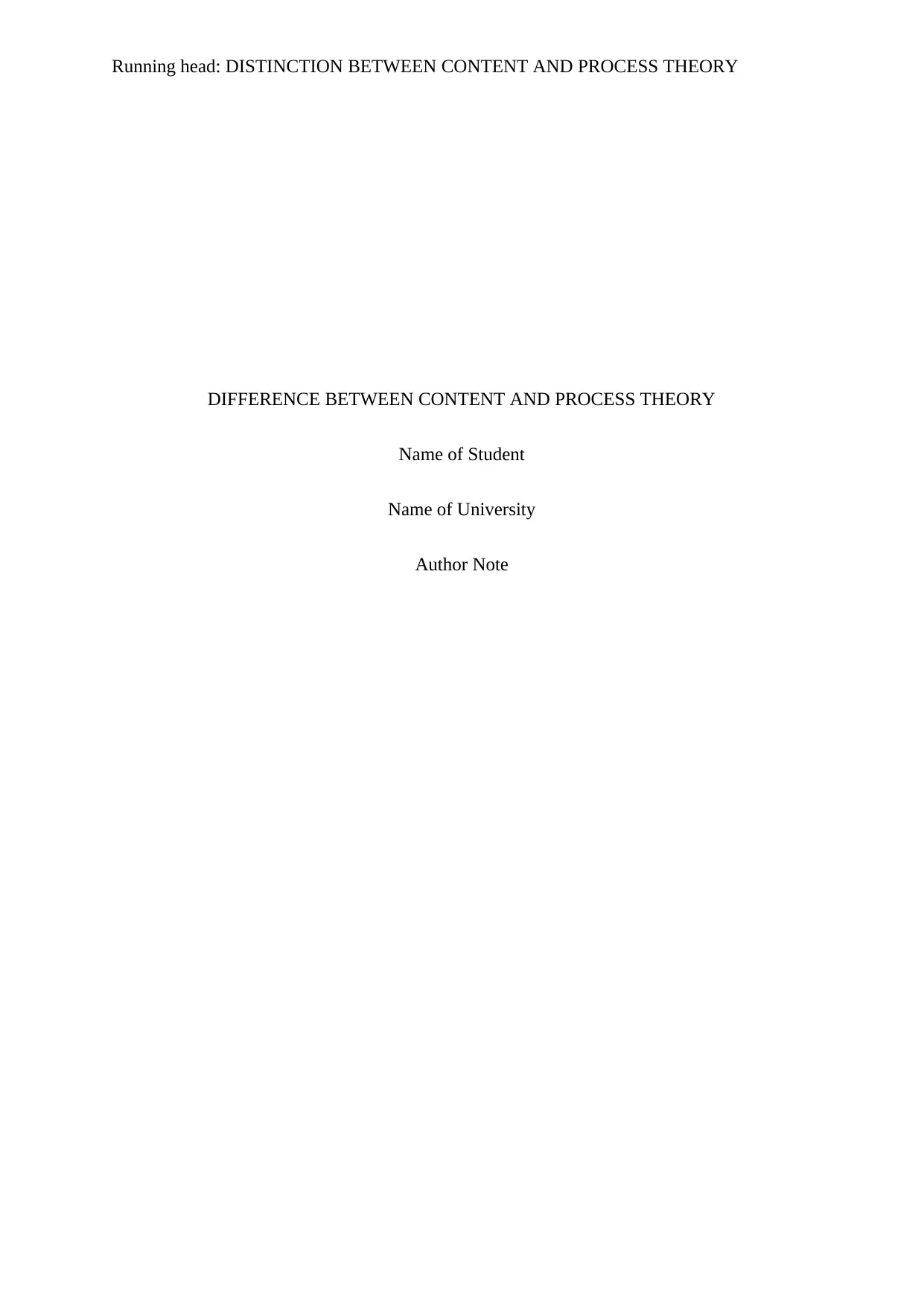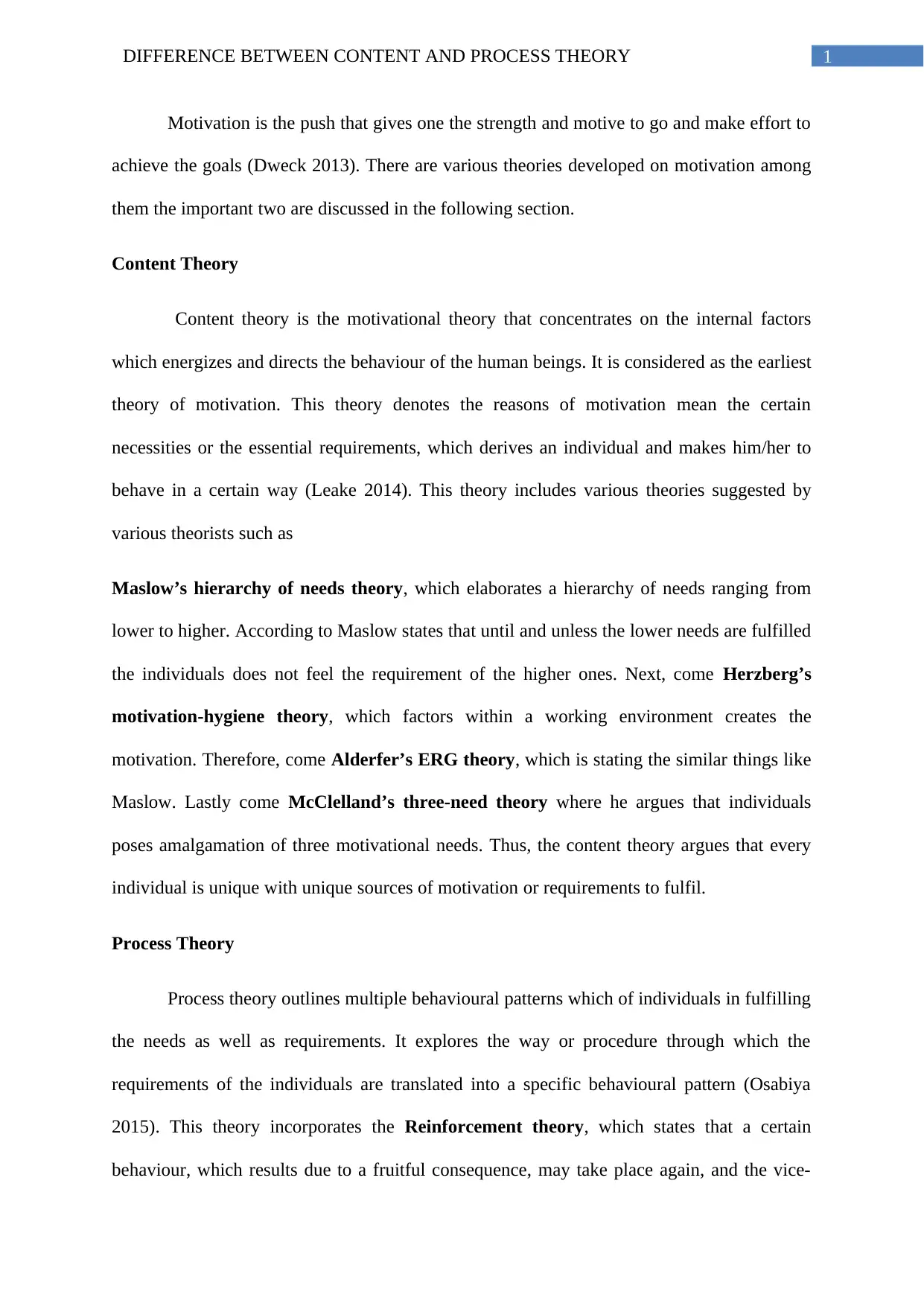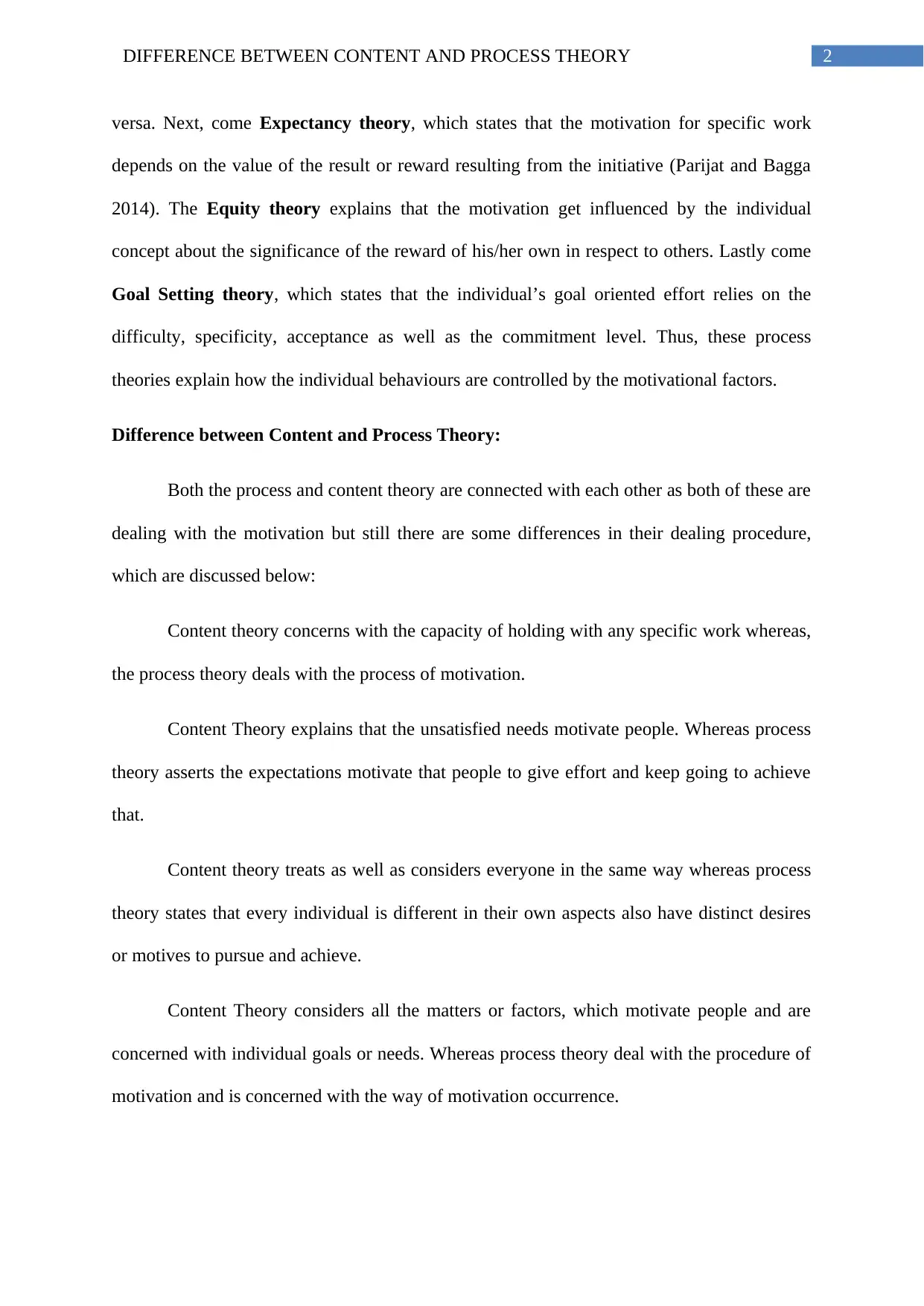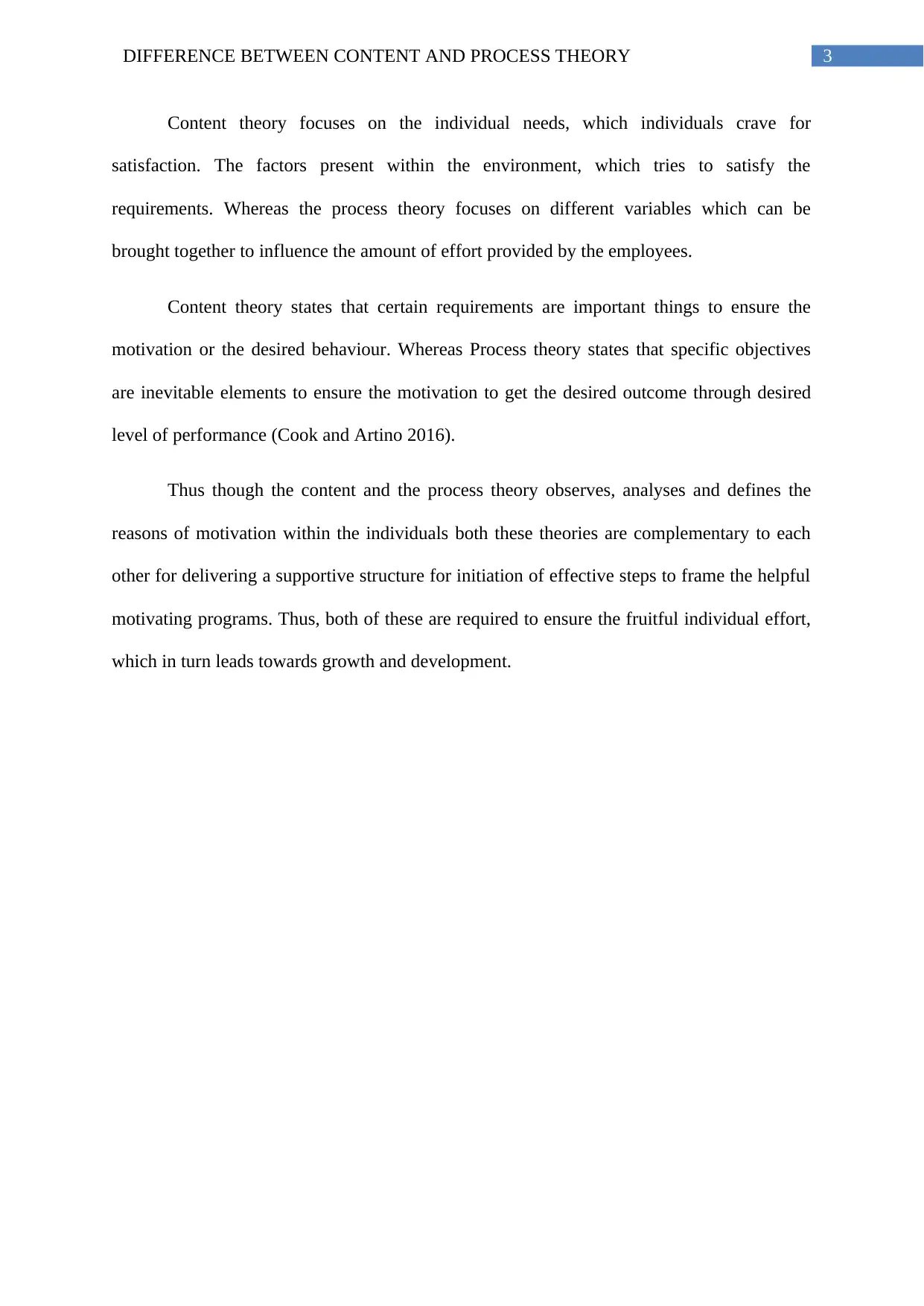Comparative Analysis of Content and Process Theories of Motivation
VerifiedAdded on 2022/11/19
|5
|944
|297
Homework Assignment
AI Summary
This assignment provides a detailed comparison between content and process theories of motivation. Content theory focuses on internal factors, such as needs, that energize behavior, including Maslow's hierarchy, Herzberg's theory, Alderfer's ERG theory, and McClelland's three-need theory. Process theory, on the other hand, examines the procedures through which needs translate into behavior, encompassing reinforcement, expectancy, equity, and goal-setting theories. The assignment highlights the differences in their approaches, with content theory emphasizing individual needs and process theory focusing on behavioral patterns and expectations. It concludes that both theories are complementary, providing a supportive structure for effective motivational programs that contribute to individual and organizational growth.

Running head: DISTINCTION BETWEEN CONTENT AND PROCESS THEORY
DIFFERENCE BETWEEN CONTENT AND PROCESS THEORY
Name of Student
Name of University
Author Note
DIFFERENCE BETWEEN CONTENT AND PROCESS THEORY
Name of Student
Name of University
Author Note
Paraphrase This Document
Need a fresh take? Get an instant paraphrase of this document with our AI Paraphraser

1DIFFERENCE BETWEEN CONTENT AND PROCESS THEORY
Motivation is the push that gives one the strength and motive to go and make effort to
achieve the goals (Dweck 2013). There are various theories developed on motivation among
them the important two are discussed in the following section.
Content Theory
Content theory is the motivational theory that concentrates on the internal factors
which energizes and directs the behaviour of the human beings. It is considered as the earliest
theory of motivation. This theory denotes the reasons of motivation mean the certain
necessities or the essential requirements, which derives an individual and makes him/her to
behave in a certain way (Leake 2014). This theory includes various theories suggested by
various theorists such as
Maslow’s hierarchy of needs theory, which elaborates a hierarchy of needs ranging from
lower to higher. According to Maslow states that until and unless the lower needs are fulfilled
the individuals does not feel the requirement of the higher ones. Next, come Herzberg’s
motivation-hygiene theory, which factors within a working environment creates the
motivation. Therefore, come Alderfer’s ERG theory, which is stating the similar things like
Maslow. Lastly come McClelland’s three-need theory where he argues that individuals
poses amalgamation of three motivational needs. Thus, the content theory argues that every
individual is unique with unique sources of motivation or requirements to fulfil.
Process Theory
Process theory outlines multiple behavioural patterns which of individuals in fulfilling
the needs as well as requirements. It explores the way or procedure through which the
requirements of the individuals are translated into a specific behavioural pattern (Osabiya
2015). This theory incorporates the Reinforcement theory, which states that a certain
behaviour, which results due to a fruitful consequence, may take place again, and the vice-
Motivation is the push that gives one the strength and motive to go and make effort to
achieve the goals (Dweck 2013). There are various theories developed on motivation among
them the important two are discussed in the following section.
Content Theory
Content theory is the motivational theory that concentrates on the internal factors
which energizes and directs the behaviour of the human beings. It is considered as the earliest
theory of motivation. This theory denotes the reasons of motivation mean the certain
necessities or the essential requirements, which derives an individual and makes him/her to
behave in a certain way (Leake 2014). This theory includes various theories suggested by
various theorists such as
Maslow’s hierarchy of needs theory, which elaborates a hierarchy of needs ranging from
lower to higher. According to Maslow states that until and unless the lower needs are fulfilled
the individuals does not feel the requirement of the higher ones. Next, come Herzberg’s
motivation-hygiene theory, which factors within a working environment creates the
motivation. Therefore, come Alderfer’s ERG theory, which is stating the similar things like
Maslow. Lastly come McClelland’s three-need theory where he argues that individuals
poses amalgamation of three motivational needs. Thus, the content theory argues that every
individual is unique with unique sources of motivation or requirements to fulfil.
Process Theory
Process theory outlines multiple behavioural patterns which of individuals in fulfilling
the needs as well as requirements. It explores the way or procedure through which the
requirements of the individuals are translated into a specific behavioural pattern (Osabiya
2015). This theory incorporates the Reinforcement theory, which states that a certain
behaviour, which results due to a fruitful consequence, may take place again, and the vice-

2DIFFERENCE BETWEEN CONTENT AND PROCESS THEORY
versa. Next, come Expectancy theory, which states that the motivation for specific work
depends on the value of the result or reward resulting from the initiative (Parijat and Bagga
2014). The Equity theory explains that the motivation get influenced by the individual
concept about the significance of the reward of his/her own in respect to others. Lastly come
Goal Setting theory, which states that the individual’s goal oriented effort relies on the
difficulty, specificity, acceptance as well as the commitment level. Thus, these process
theories explain how the individual behaviours are controlled by the motivational factors.
Difference between Content and Process Theory:
Both the process and content theory are connected with each other as both of these are
dealing with the motivation but still there are some differences in their dealing procedure,
which are discussed below:
Content theory concerns with the capacity of holding with any specific work whereas,
the process theory deals with the process of motivation.
Content Theory explains that the unsatisfied needs motivate people. Whereas process
theory asserts the expectations motivate that people to give effort and keep going to achieve
that.
Content theory treats as well as considers everyone in the same way whereas process
theory states that every individual is different in their own aspects also have distinct desires
or motives to pursue and achieve.
Content Theory considers all the matters or factors, which motivate people and are
concerned with individual goals or needs. Whereas process theory deal with the procedure of
motivation and is concerned with the way of motivation occurrence.
versa. Next, come Expectancy theory, which states that the motivation for specific work
depends on the value of the result or reward resulting from the initiative (Parijat and Bagga
2014). The Equity theory explains that the motivation get influenced by the individual
concept about the significance of the reward of his/her own in respect to others. Lastly come
Goal Setting theory, which states that the individual’s goal oriented effort relies on the
difficulty, specificity, acceptance as well as the commitment level. Thus, these process
theories explain how the individual behaviours are controlled by the motivational factors.
Difference between Content and Process Theory:
Both the process and content theory are connected with each other as both of these are
dealing with the motivation but still there are some differences in their dealing procedure,
which are discussed below:
Content theory concerns with the capacity of holding with any specific work whereas,
the process theory deals with the process of motivation.
Content Theory explains that the unsatisfied needs motivate people. Whereas process
theory asserts the expectations motivate that people to give effort and keep going to achieve
that.
Content theory treats as well as considers everyone in the same way whereas process
theory states that every individual is different in their own aspects also have distinct desires
or motives to pursue and achieve.
Content Theory considers all the matters or factors, which motivate people and are
concerned with individual goals or needs. Whereas process theory deal with the procedure of
motivation and is concerned with the way of motivation occurrence.
⊘ This is a preview!⊘
Do you want full access?
Subscribe today to unlock all pages.

Trusted by 1+ million students worldwide

3DIFFERENCE BETWEEN CONTENT AND PROCESS THEORY
Content theory focuses on the individual needs, which individuals crave for
satisfaction. The factors present within the environment, which tries to satisfy the
requirements. Whereas the process theory focuses on different variables which can be
brought together to influence the amount of effort provided by the employees.
Content theory states that certain requirements are important things to ensure the
motivation or the desired behaviour. Whereas Process theory states that specific objectives
are inevitable elements to ensure the motivation to get the desired outcome through desired
level of performance (Cook and Artino 2016).
Thus though the content and the process theory observes, analyses and defines the
reasons of motivation within the individuals both these theories are complementary to each
other for delivering a supportive structure for initiation of effective steps to frame the helpful
motivating programs. Thus, both of these are required to ensure the fruitful individual effort,
which in turn leads towards growth and development.
Content theory focuses on the individual needs, which individuals crave for
satisfaction. The factors present within the environment, which tries to satisfy the
requirements. Whereas the process theory focuses on different variables which can be
brought together to influence the amount of effort provided by the employees.
Content theory states that certain requirements are important things to ensure the
motivation or the desired behaviour. Whereas Process theory states that specific objectives
are inevitable elements to ensure the motivation to get the desired outcome through desired
level of performance (Cook and Artino 2016).
Thus though the content and the process theory observes, analyses and defines the
reasons of motivation within the individuals both these theories are complementary to each
other for delivering a supportive structure for initiation of effective steps to frame the helpful
motivating programs. Thus, both of these are required to ensure the fruitful individual effort,
which in turn leads towards growth and development.
Paraphrase This Document
Need a fresh take? Get an instant paraphrase of this document with our AI Paraphraser

4DIFFERENCE BETWEEN CONTENT AND PROCESS THEORY
References
Dweck, C.S., 2013. Self-theories: Their role in motivation, personality, and development.
Psychology press.
Leake, D.B., 2014. Evaluating explanations: A content theory. Psychology Press.
Osabiya, B.J., 2015. The effect of employees motivation on organizational
performance. Journal of public administration and policy research, 7(4), pp.62-75.
Cook, D.A. and Artino Jr, A.R., 2016. Motivation to learn: an overview of contemporary
theories. Medical education, 50(10), pp.997-1014.
Parijat, P. and Bagga, S., 2014. Victor Vroom’s expectancy theory of motivation–An
evaluation. International Research Journal of Business and Management, 7(9), pp.1-8.
References
Dweck, C.S., 2013. Self-theories: Their role in motivation, personality, and development.
Psychology press.
Leake, D.B., 2014. Evaluating explanations: A content theory. Psychology Press.
Osabiya, B.J., 2015. The effect of employees motivation on organizational
performance. Journal of public administration and policy research, 7(4), pp.62-75.
Cook, D.A. and Artino Jr, A.R., 2016. Motivation to learn: an overview of contemporary
theories. Medical education, 50(10), pp.997-1014.
Parijat, P. and Bagga, S., 2014. Victor Vroom’s expectancy theory of motivation–An
evaluation. International Research Journal of Business and Management, 7(9), pp.1-8.
1 out of 5
Related Documents
Your All-in-One AI-Powered Toolkit for Academic Success.
+13062052269
info@desklib.com
Available 24*7 on WhatsApp / Email
![[object Object]](/_next/static/media/star-bottom.7253800d.svg)
Unlock your academic potential
Copyright © 2020–2025 A2Z Services. All Rights Reserved. Developed and managed by ZUCOL.





